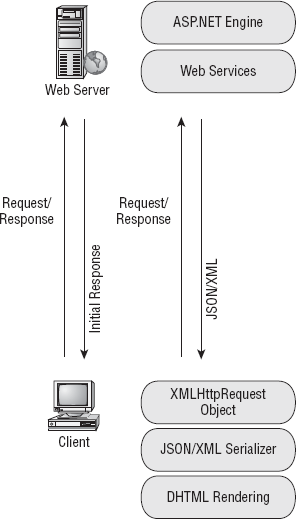1.4. Technologies of AJAX
Almost a decade ago, the Microsoft Exchange Server team created an ActiveX control called XMLHttpRequest that could be instantiated from JavaScript and used to communicate with the server. Using the XMLHttpRequest object, you could send information to the server and get data back without clearing the screen and painting a completely new HTML page. JavaScript code could then manipulate the HTML dynamically on the client, avoiding the annoying flash and the wait that users associate with Web browsing. This functionality was not limited to Internet Explorer for long. Soon, other browsers included XMLHttpRequest objects as well. Developers could now write richer applications with their reach extending across various operating systems.
Figure 1-2. Figure 1-2

The browsers that can make use of this object include the following:
Internet Explorer 5.0 and above (currently in version 8.0)
Safari 3.1
Firefox 3
Opera 8+
Netscape 9
The browsers also created an advanced Document Object Model (DOM) to represent the browser, the window, the page, and the HTML elements it contained. The DOM exposed events and responded to input, allowing the page to be manipulated with script. Dynamic HTML (DHTML) opened the door to writing rich interfaces hosted within the Web browser. Developers started writing hundreds and even thousands of lines of JavaScript code to make rich and compelling ...
Get Professional ASP.NET 3.5 AJAX now with the O’Reilly learning platform.
O’Reilly members experience books, live events, courses curated by job role, and more from O’Reilly and nearly 200 top publishers.

